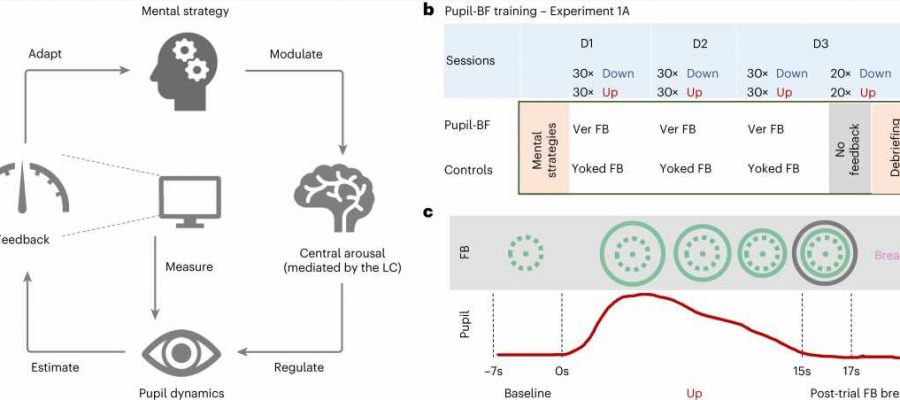
Our pupils are a mirror of our state of arousal: they dilate when we are tense, stressed or even panicky, and constrict when we calm down. Key to this is an area of the brain measuring about 15 millimeters: a nucleus in the pons of the brainstem known as locus coeruleus. Located deep in the brain, it regulates our state of arousal via the neurotransmitter noradrenaline.
Up until now, it had been unclear whether information about pupil size can also be used to volitionally influence the arousal centers in the brain. A new study conducted at ETH Zurich now shows that this is indeed possible. “With the right biofeedback, people can better learn to control their state of arousal through mental relaxation and activation techniques,” explains Nicole Wenderoth, Professor of Neural Control of Movement at ETH Zurich.
The results of the study open up new possibilities in the treatment of stress- and anxiety-related disorders.
Pupil feedback is key
To investigate the relationship between pupil size and the brain’s state of arousal, the researchers first taught a group of 27 subjects to volitionally control their pupil size. Using mental relaxation and activation techniques, such as focusing on breathing and visualizing stressful or threatening situations, the subjects were asked to alternately constrict and dilate their pupils. They sat in front of a screen with an eye tracker that recorded how well they were doing.
The researchers showed this feedback to some of the subjects in the form of a circle on the screen. A shrinking circle indicated to the subjects that their pupils were constricting: a sign of relaxation. An expanding circle, by contrast, indicated dilating pupils and rising arousal.
The researchers found that individuals who received real-time feedback about their pupil size were better able to control their state of arousal and pupil size. This pupil feedback allowed subjects to identify the relaxation and activation techniques that worked best for them. By contrast, the control group either received a false feedback signal unrelated to their own pupil size or were instructed to focus purely on the use of mental strategies.
MRI shows activity in the locus coeruleus
The researchers then repeated the experiment, except this time they recorded the subjects’ brain activity using magnetic resonance imaging. “We saw that volitional changes in pupil size are actually accompanied by changes in activity in brainstem regions that regulate the brain’s state of arousal,” says Sarah Meissner, a postdoctoral researcher in Wenderoth’s research group.
A look at the subjects’ heart rates revealed that the change in pupil size also physically relaxed or roused them. The pulse of those who were able to control their pupils better due to the feedback fell or rose more at the end of the training compared to the beginning of the training and more than the pulse of those in the control group.
The ETH researchers’ method translates well to commercially available VR headsets that provide real-time feedback on pupil size. “Our goal is for people to learn to control their pupils in a playful way and, in doing so, find out which relaxation or activation techniques work best for them,” Wenderoth says. The researchers have already founded an ETH spin-off, Mindmetrix, to bring this technology to market.
The research is published in Nature Human Behavior.
More information:
Meissner, S.N. et al, Self-regulating arousal via pupil-based biofeedback, Nature Human Behavior (2023). DOI: 10.1038/s41562-023-01729-z. www.nature.com/articles/s41562-023-01729-z
Journal information:
Nature Human Behaviour
Source: Read Full Article
